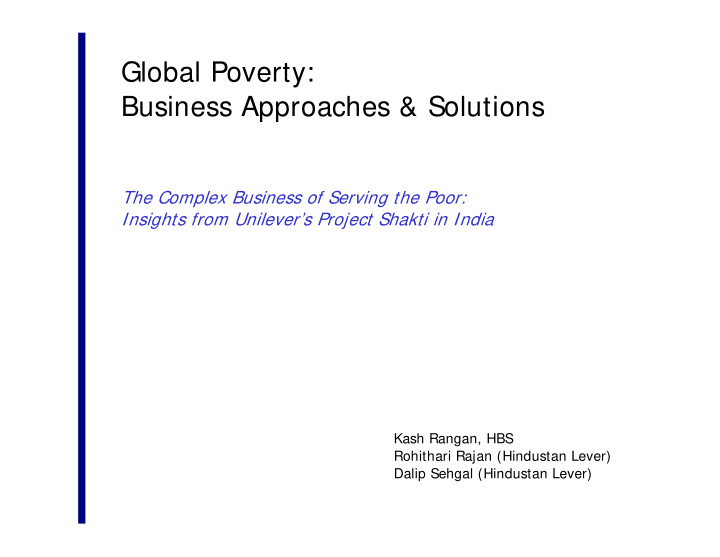



Global Poverty: Business Approaches & Solutions The Complex Business of Serving the Poor: Insights from Unilever’s Project Shakti in India Kash Rangan, HBS Rohithari Rajan (Hindustan Lever) Dalip Sehgal (Hindustan Lever)
Hindustan Lever Limited Background $2.3 billion subsidiary of $50 billion global food giant Has operated in India since 1933; HLL was formed in 1956 Operates 4 business units: Detergents, Personal Care, Beverages, Foods Gross Margins: 40% to 45% Net Margins: 10% to 15% Market share of about 45% across categories Built a reputation for strong management and corporate values
Structure of Competition in Indian Markets Global and National HLL, P&G, Colgate Palmolive, Godrej Soaps Local Brands Unattended Local Innovation: Example, Nirma, building up since seventies Global Entry: Heating up since the nineties
Structure of HLL’s Market Reach in India 250 million Retail Stockist Program Urban Consumers 250 million L.A.B. Program Semi-Urban IDC Program Rural Consumers Streamline Program 250 million Consumers Shakti in villages with 500 or more people 250 million Consumers In small villages Annual Per-Capital Income $600 ($3,000 PPP) Market Size of Urban and Rural Approximately Equal
Distribution of Villages in India Population Number of Villages % of Total Less than 114,267 17.9% 200 200-499 155,123 24.3% 500-999 159,400 25.0% 1,000-1,999 125,758 19.7% 2,000-4,999 69,135 10.8% 5,000-9,999 11,618 1.8% 10,000 and 3,064 0.5% above Total 638,365 100% Source: Selling to the Hinterland, Pradeep Kashyap, The Businessworld Marketing Whitebook 2003-04
Hindustan Lever Sales Offices Regional Sales Office Regional Sales Office Headquarters Project Shakti: Original Launch Site Regional Sales Office Regional Sales Office Project Shakti: Shaded areas Source: HLL
Urban Stores Self-Service Store Retail Store Source: HLL
Source: HLL Rural Retail Stores
Appearance of iShakti Kiosks Source: HLL
Source: HLL A Shakti Entrepreneur
Source: HLL Shakti Vani: The Communicator
Economic and Social Benefits Shakti Entrepreneur Sales $250/month $3,000/year Earnings about 7%, after 3% goes towards principal ($250) and interest Improves her per-capita income by about 50% to 100% 100,000 entrepreneurs by 2010 So, Social Benefit equals $20 to $30 million HLL SalesTurnover of about $250 million If all goes well, Net Margins of about $25 million
Challenges 1. Scaling up for economic profit. Moving from variable cost to fixed cost model. Significance of Partnerships with NGO sector and Government sector in 2. building Commercial infrastructure (even Competitors). Sustainability and Attention. 3. Multinationals’ Dilemma
Recommend
More recommend